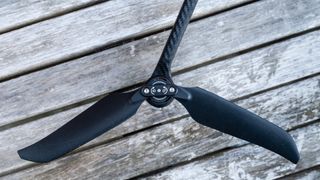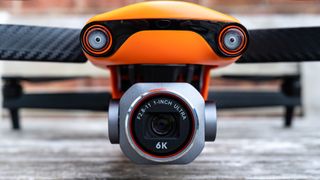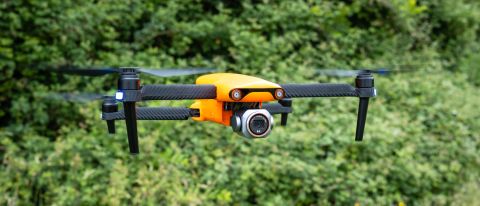Space Verdict
A highly capable and powerful drone offering features suitable for professional use that includes a camera with an adjustable aperture, 1-inch sensor, and many more advanced features.
Pros
- +
Up to 5.4K video and Raw Photos
- +
Adjustable aperture
- +
Subject tracking and cinematic flight modes
Cons
- -
Some shooting modes only available in Auto
- -
Log Color only available in Auto
- -
Controller battery life could be better
Why you can trust Space.com
Weight: 29.45 oz / 835 g
Dimensions: 210 × 123 × 95 mm (Folded) / 427 × 384 × 95 mm (Unfolded)
Battery: 6175 mAh LiPo 3S / up to 40 minutes
Charger type: AC Mains 100-240V/50-60 Hz
Modes: Ludicrous, Standard, Smooth
Video transmission range: FCC 7.4 miles / 12 km and CE 3.7 miles / 6 km
Video resolution: 5.4K, 4K, 2.7K, 1080p (FHD)
Frame rates: 5.4K up to 30 fps / 4K up to 60 fps / 2.7K up to 60 fps / FHD up to 120 fps
When the first drone with a 1-inch sensor was released, it was something of a revelation and this sensor size remains a popular choice for enthusiasts and professionals alike. The Autel EVO Lite+ is the latest drone to feature a 1-inch sensor and takes the helm as Autel’s flagship model. Sitting between the DJI Mavic Air 2S and DJI Mavic 3 in terms of camera functionality, the Lite+ is arguably in a class of its own.
The Autel EVO Lite+ was released in January 2022 alongside two variations of the Autel EVO Nano and a smaller sensor Autel EVO Lite model. The Lite+ is the most advanced drone in the line-up and offers a 20MP 1-inch sensor in a camera with an equivalent focal length of 29 mm and an adjustable f/2.8 – f/11 aperture. Photos can be captured in JPEG and RAW, while video can be captured in Standard and Log Color in 5.4K up to 30 fps, 4K up to 60 fps, 2.7K up to 60 fps and HD up to 120 fps.
Flight times are advertised at up to 40 minutes, and with speeds of up to 40 mph possible and level 7 wind resistance (up to 38 mph), the Lite+ is undoubtedly a powerful drone. But while all this power suggests the drone might be something of a brute, controls are smooth and responsive for precision control, and the cinematic Smooth flight mode provides slower and smoother flight for capturing video.
If you’re interested in checking out other drones out there our best beginner drones and best drones guides will help you.
Autel EVO Lite+: Design
- Folding design
- Excellent build quality
- Available in three colors
The Autel EVO Lite+ features a folding design that makes it much more compact for transportation and storage. Folded, the drone is 210 × 123 × 95 mm and 427 × 384 × 95 mm unfolded, alongside a weight of 835 g. Build quality overall is excellent, and the Lite+ is available in three colors – Classic Orange, Deep Space Gray, and Arctic White so you can select the option you prefer.





Thanks to the high capacity 6175 mAh flight batteries, the Lite+ is advertised as being able to offer flight times of up to 40 minutes. In real-world flying conditions, flight times are just over 30 minutes, which is still impressive, and takes into account the default Return to Home (RTH) when batteries reach a minimum charge of 25%. This can be adjusted in the app, but it’s best to leave RTH at the default to ensure a safe and reliable Return to Home when required.
The controller for the Lite+ is Autel’s standard controller that’s used for both the Lite and Nano series drones. It resembles a gaming controller with a textured surface for grip, and all the controls you need for flight and basic camera operation are available, including one customizable Fn button with single and double-click functionality. Most settings and camera controls are accessed via the AutelSky app on your smartphone, which connects to a phone holder at the top of the controller.


Overall, the controller is comfortable and intuitive to use, but it doesn’t offer storage for the thumb sticks when these are removed for transportation, and there’s nowhere to store the phone cable on the controller either. Although these certainly aren’t dealbreakers.
Battery life lasts roughly as long as three drone batteries, so just enough juice if you buy the Premium Bundle that includes three batteries. Drone pilots using more than three batteries would have to charge the controller on the go, but with three flight batteries providing over 1.5 hours of flight this may be enough for most people.


Autel EVO Lite+: Functionality
- Level 7 wind resistance (up to 38 mph)
- Collision avoidance, subject tracking, and QuickShots
- Subject tracking
With level 7 wind resistance (up to 38 mph) and a top speed of 40 mph in Ludicrous mode, the Lite+ is undoubtedly a powerful drone capable of flight in a variety of conditions. During testing, the drone was flown in winds gusts up to 30 mph and had no problem flying in Standard mode, which has a top speed of 22 mph. The third mode available is Smooth, with a top speed of 11 mph, which is designed for capturing smoother and more cinematic-looking video footage.

The ability to fly safely in both calm and windy conditions is always useful because there are times when winds are too strong for smaller and less powerful drones. During flight, the Lite+ is incredibly smooth in the air within its wind resistance level and responds perfectly to controls. In terms of safety, there’s GPS positioning as you’d expect to hold the drone in position, plus there’s collision avoidance that uses front, bottom, and rear ultra-wide-angle sensors.
When an obstacle is detected, the Autel EVO Lite+ initially reduces speed and will brake completely if a potential collision is detected. It’s a sensitive system, which is fantastic in some situations, but in complex environments where there are multiple obstacles, the drone will fly slowly although smooth flight is maintained.


The Lite+ offers several shooting and flying modes including QuickShots automated flight patterns for capturing professional-looking video with ease. These include Rocket, Fade Away, Orbit, and Flick, and all work well. There’s also Dynamic Track subject tracking for tracking moving subjects, and this provides three modes: one where the moving subject is followed, another where the camera follows the subject and you manually fly the drone, and a third where the drone hovers and the camera follows the subject.
Autel EVO Lite+: Performance
- 20 MP camera with adjustable aperture
- Up to 5.4K video at 30 fps
- Excellent image quality
The Autel EVO Lite+ camera houses a 20MP 1-inch sensor and offers an equivalent focal length of 29 mm alongside an adjustable f/2.8 – f/11 aperture. The adjustable aperture is most useful for videographers because it allows them greater control over exposure, alongside ND filters, while in the air. f/2.8 – f/5.6 are the sharpest settings with the latter providing the largest depth-of-field, although beyond this diffraction becomes noticeable. This is arguably less noticeable with video, but f/8 is the most you’d want to stop down to.

The ISO range is from 100-6400 and results are excellent throughout, although the higher you go the more noticeable the grain becomes. Results are certainly usable up to ISO 6400, but ISO 100-400 is the optimal range while up to ISO 1600 remains good overall. It’s fair to say that the Autel EVO Lite+ performs similarly to entry-level DSLRs and mirrorless cameras in this area.
The image quality produced by the Lite+ camera is excellent overall. When it comes to photos there is a small amount of fall-off in sharpness towards the edges of the frame and a hint of barrel distortion, but the former is common with all consumer drones and the latter can be corrected easily in software such as Lightroom.





Video quality is excellent with sharp detail and natural colors captured even with the Standard color profile. A Log Color option is available, but its use is limited to Auto, so hopefully this will be extended to Pro/Manual mode in a future firmware update. Log Color is important for professional workflows, and manual shooting is the preferred method of capture for several reasons. AEB (auto exposure bracketing) and HDR video are also only available when shooting in Auto.
In terms of video resolutions, the Autel EVO lite+ can capture 5.4K up to 30 fps, 4K up to 60 fps, 2.7K up to 60 fps and HD up to 120 fps. Hyperlapse videos are captured in 4K at 25 fps. Video is captured in 8-bit, in either H265/H264 codecs with a maximum bitrate of 120Mbps.
When shooting in Hyperlapse mode, the Lite+ combines images into a video file automatically and you can opt for video only, video plus JPEGs, or video plus Raw files. What’s more, the drone can be set to orbit a subject, hover in position, or manual flight allowing you to set the direction of flight manually which can then be held using a cruise mode so you can release the controls.
Autel EVO Lite+ review: Price
Alongside the features and functionality on offer, one of the most attractive aspects of the Autel EVO Lite+ is its competitive price tag. The Standard kit, which includes the drone, one battery, a controller, charger, USB-C cable, three phone cables, and a pair of spare propellers costs $1,379/£1,249. One battery is never enough because it limits flight times on days out, so the Premium/Fly More Bundle is by far the better option.
The Premium Bundle includes everything that the Standard Bundle has but includes two additional batteries, two extra pairs of spare propellers, ND filters (ND4/ND8/ND16/ND32), a three-battery charging hub, and a shoulder bag that carries everything. This comprehensive kit costs $1,679/£1,519, so marginally more expensive than the Standard Bundle and less expensive than purchasing all the accessories separately.
Should you buy the Autel EVO Lite+?
The Autel EVO Lite+ offers excellent value for money alongside all of the features most people will ever need. The drone does have a few quirks, such as several shooting modes that only work with Auto mode rather than Pro/Manual, but these will hopefully be ironed out in future firmware updates. This could, however, be an issue for professional videographers since Log Color is only available in Auto.
That said, video is possible up to 5.4K at up to 30 fps and 4K up to 60 fps, so if future firmware updates can be used to add manual control across all shooting modes, the Lite+ will become a formidable option. The Lite+ drone is the best DJI alternative available and with obstacle avoidance, subject tracking, and QuickShots for automated cinematic footage alongside video capture up to 5.4K, the Lite+ is a compelling option for enthusiasts and professionals.
If this product isn't for you
The Autel EVO Lite+ is a medium size drone, so if you’re looking for something smaller and lighter, the 249 g Autel EVO Nano+ or the 249 g DJI Mavic Mini 3 Pro are both great options. These drones all have a smaller sensor than the Lite+ and are less powerful, but they do offer collision avoidance and QuickShots automated flight modes for capturing cinematic footage at the touch of a button.
If you’d like to take advantage of the best image quality available in a sub 900 g drone, the DJI Mavic 3 with its Four Thirds main camera and second telephoto camera could be an option. General features and functionality are similar to the Lite+, but the Mavic 3 is considerably more expensive, so you’ll need a bigger budget. That and the image quality isn’t a great deal better than the Lite+.
Join our Space Forums to keep talking space on the latest missions, night sky and more! And if you have a news tip, correction or comment, let us know at: community@space.com.
James is an award-winning freelance landscape and portrait photographer, as well as a highly experienced photography journalist working with some of the best photography magazines and websites with a worldwide audience. He’s also the author of The Digital Darkroom: The Definitive Guide to Photo Editing. www.jamesaphoto.co.uk

